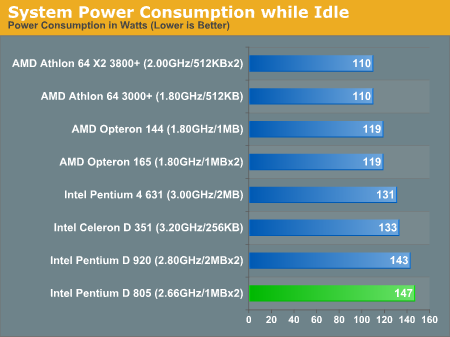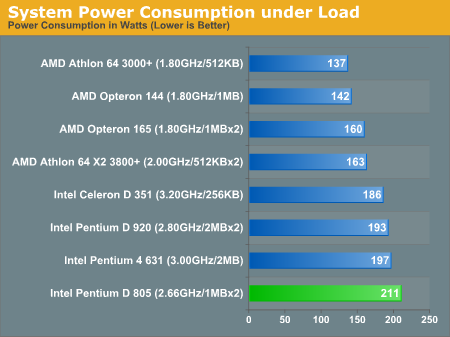Intel Pentium D 805 - Dual Core on a Budget
by Anand Lal Shimpi on April 7, 2006 12:00 AM EST- Posted in
- CPUs
Power Consumption
As always, we measured power consumption of the entire system at the wall outlet. First up is power consumption with the test system at idle. Here AMD's Cool 'n Quiet and Intel's EIST really come into play and do their best to reduce power consumption:

As you can expect, based on the old 90nm Smithfield core, the Pentium D 805 isn't exactly the coolest running chip on the block. In fact, the Athlon 64 3000+ consumes less power under full load than the Pentium D 805 does with both of its cores idling. Note that the higher power consumption on the two Opteron parts is because Cool 'n Quiet would not work with the Opterons on our test platform.

The picture doesn't get any prettier under full load. If you're expecting the Pentium D 805 to be a cool running, quiet chip, you're going to be sorely disappointed. If power consumption matters to you then you're far better off with a Pentium D 900 series or an Athlon 64 X2.
Looking at the long-term prospects, power costs money, so how long will it be before the lower power X2 3800+ reaches the break-even point? If we go with a typical $.10 per kWHr, the X2 3800+ consumes 37W less at idle and 48W less at full load. If that seems like a lot of power initially, it actually only works out to $32-$42 per year, running both systems 24/7. That means you're looking at a minimum of four years to reach equivalence in price+power. What about the 920 versus 805 power costs? The difference there is even less in terms of power use, so even at full load you're looking at $16 per year, or seven years to reach the break-even point.
Of course, you can't just look at power in most instances. The X2 3800+ will offer you faster performance during its lifetime, so it definitely warrants consideration. Lower power, lower heat, lower noise, and higher performance are all nice things to have.
Note: Pentium D 820 numbers were excluded from the power comparison due to technical difficulties with our test platform at the last minute. Based on the data here, you can expect it to consume more power than the Pentium D 805.










51 Comments
View All Comments
JakeBlade - Tuesday, April 11, 2006 - link
I love how this site does a power consumption test with like the only two dual core P4s that don't have ESST. Don't be afraid to run a P4D 950 with ESST and see how it's power consumption compares to the X2/Opteron.ashr7870 - Wednesday, March 23, 2016 - link
Old comment, I know, but it would be the same as the D-820, since the Prescott/Smithsfield/Presler implementation of SpeedStep only reduces speeds to 2.8GHz, or x14 - minimum multiplier on the D's. All Anand would get out of running a 950 is higher load power.jballs - Saturday, April 8, 2006 - link
Dang i haven't even hooked up my 144 yet and I see that quake 4 benchmark. It got beat pretty badly by dual cores. Im guess the numbers are the average frame rate, do the minimum frame rates tell any diffent of a story? Were the single core CPU's tested on the using the patch for dual cores? Anybody know of a possibility that that patch would lower single core perf.? Man if this is a sign of things to come i might have wnated to go with a dual core even though I only care about game performance.poohbear - Saturday, April 8, 2006 - link
well i dont think dual cores will go mainstream until the UT2007 engine is released, as it's built from the ground up to be a multithreaded application. quake4 is an exception, although oblivion states it supports multithreading but have'nt seen any testing done on it.phillock - Tuesday, January 30, 2018 - link
this might help you https://visual.ly/community/Infographics/entertain...peternelson - Friday, April 7, 2006 - link
At the moment the 805 is a good deal and has been heavily discounted.
However, from the recent anandtech story about intel pricing, the price of 9xx chips is due to REDUCE quite a bit on 23 and/or 30 April.
And further big reductions on say 950 are due when Conroe launches (even if it is in small volumes then).
My point is that the RELATIVE BARGAIN of the 805 now will be rivalled by 9xx on a price/performance/cost/benefit basis. ie it has Hardware virtualisation, is COOLER for the given amount of work, and with the new 9xx steppings, will be further improved in April. Thus the 805 will still be good value but not as far ahead of 9xx as it is now.
You are right that as a budget "stop-gap" until Conroe it is tempting, which makes it all the more useful if 975X "conroe-ready" boards could be made NOW with "conroe ready" stickers slapped on the boxes.
Once the price drops, 930 should be more attractive than they are today. Also intels roadmap still shows 950 quite a while into the future so (again after the price drop) that could be good to go for.
If I can't locate a Conroe ready 975X board to put some current intel processor into soon, I may have to spend money as soon as AMD have AM2 chips out (15 May to system builders) and a corresponding AM2 motherboard.
JarredWalton - Friday, April 7, 2006 - link
I have to say, though, that getting a 975X motherboard and slapping in a PD 805 is a bit of a mismatch. Most 975X boards cost in the neighborhood of $200 or more, so I'd be looking more at a cheap 775 motherboard with a cheap 805 CPU to hold you over. That's what I've got right now (as one PC - runs Folding@Home quite well for the price!)xtremejack - Saturday, April 8, 2006 - link
As of April, all 975XBX mobos are Conroe-readypeternelson - Saturday, April 8, 2006 - link
From April.... All 975X motherboards are Conroe ready
Interesting....
I can buy a 975XBX Intel board from a local reseller.
Actually we are Intel resellers/processor integrators ourselves!
But HOW CAN I TELL the difference between an early 975XBX that was NOT Conroe ready without component and wire mods, from the NEW 975XBX which is conroe ready already?
Is it some board revision number marked on the board?
Is it some "conroe ready" sticker on the box and/or board?
If I can't find rival vendors offering 975X board for conroe I may have to buy the own brand intel one (although this was not anand's first choice when reviewed), but even then I need a CLEAR way to differentiate between a conroe-ready version of it and a not ready.
Is there a link to Intel information about the differences?
"From April" is pretty useless as there is a timelag between USA availability and stock reaching distribution channels in the UK so we can buy it off them. Also the problem of distributors holding stock and selling it after the changeover date. I need a way to tell the difference.
JackPack - Saturday, April 8, 2006 - link
As you're aware, "April" alone is meaningless. In fact, it's misleading.There is a PCN (106056-00) on Intel's website describing the updated D975XBX. The newer D975XBX (non-system integrator version) carries an altered assembly number ending with -304.